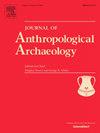Variation in ancient Maya governance: A long-term perspective from the central palace at Yaxnohcah, Mexico
IF 2.2
1区 社会学
Q1 ANTHROPOLOGY
引用次数: 0
Abstract
Archaeology has seen a recent reemergence of interest in ancient forms of governance and variations in political institutions across time and space. While studies of ancient Maya politics have frequently assumed a unified political system, an increasing pool of data suggests that there was in fact a high degree of variability regarding governance and political practice. Here we discuss changes in rulership and power relations from the perspective of the inhabitants of the central palace at Yaxnohcah, focusing on social and political transformations in and beyond the site. Rulership at Yaxnohcah materialized in the Late Preclassic (400 BCE–200 CE), but associated practices shifted focus from community integration to the establishment of a central court identity in the Early Classic (200–600 CE), until courtly privileges were significantly reduced after a political regime change at nearby Calakmul around 636 CE. This case study shows how political institutions constantly adapted to a fluctuating political landscape, which implied profound shifts in both practice and ideology. It also discusses how collective decision-making may have been more pronounced at Yaxnohcah than at other contemporary sites, providing an important datapoint for a general reevaluation of variation in governance in the Maya area and beyond.
古玛雅统治的变化:从墨西哥亚克斯诺卡中央宫殿的长期视角
考古学最近发现,人们对古代治理形式和跨越时空的政治制度的变化重新产生了兴趣。虽然对古玛雅政治的研究经常假设一个统一的政治制度,但越来越多的数据表明,事实上,在治理和政治实践方面存在高度的可变性。在这里,我们从Yaxnohcah中央宫殿居民的角度讨论统治和权力关系的变化,重点关注该遗址内外的社会和政治变革。Yaxnohcah的统治在前古典晚期(公元前400年-公元200年)实现,但相关的实践在早期古典时期(公元200-600年)将重点从社区整合转移到建立中央法院身份,直到公元636年附近的Calakmul发生政治政权更迭后,法院特权显著减少。这个案例研究展示了政治制度如何不断适应波动的政治格局,这意味着实践和意识形态的深刻转变。它还讨论了集体决策如何在雅克斯诺卡比在其他当代遗址更明显,为普遍重新评估玛雅地区及其他地区的治理变化提供了重要的数据点。
本文章由计算机程序翻译,如有差异,请以英文原文为准。
求助全文
约1分钟内获得全文
求助全文
来源期刊

Journal of Anthropological Archaeology
Multiple-
CiteScore
4.00
自引率
11.10%
发文量
64
期刊介绍:
An innovative, international publication, the Journal of Anthropological Archaeology is devoted to the development of theory and, in a broad sense, methodology for the systematic and rigorous understanding of the organization, operation, and evolution of human societies. The discipline served by the journal is characterized by its goals and approach, not by geographical or temporal bounds. The data utilized or treated range from the earliest archaeological evidence for the emergence of human culture to historically documented societies and the contemporary observations of the ethnographer, ethnoarchaeologist, sociologist, or geographer. These subjects appear in the journal as examples of cultural organization, operation, and evolution, not as specific historical phenomena.
 求助内容:
求助内容: 应助结果提醒方式:
应助结果提醒方式:


